Embarking on a journey through the intricate world of artisan crafts, we delve into the rich tapestry of possibilities woven by seagrass. This compilation unravels the diverse applications and the array of products that emerge from the skilled artistry of utilizing seagrass for weaving.
From functional items to exquisite creations, the versatility of seagrass takes center stage, showcasing its role as a remarkable and sustainable material in the realm of weaving.
Contents [hide]
1. What Seagrass Is Used For Weaving?
Seagrass refers to a group of flowering plants that grow underwater in marine environments, typically in shallow coastal waters. The plant itself is a type of grass, and its long, sturdy, and flexible stems are harvested for various purposes.
In Vietnam, seagrass is a herbaceous plant that thrives in the Northern and North Central provinces, particularly in regions like Thanh Hoa, Ninh Binh, and Quang Ninh.
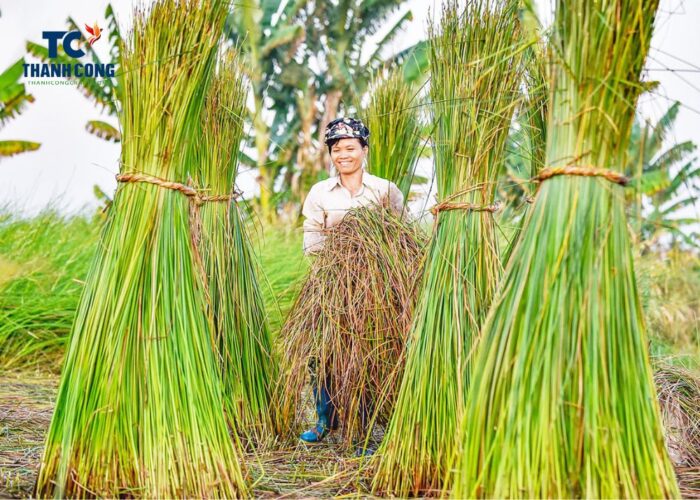
The cultivation of sedge has given rise to unique craft villages, with Kim Son sedge village in Ninh Binh being one of the most prominent examples. Here, the sedge is skillfully transformed into various handicrafts. Additionally, artisans combine sedge with other materials to create everyday furniture and other practical items.
Seagrass has many advantages when used for weaving, such as durability, softness, comfort, resistance to mold and mildew, and natural and attractive colors. Seagrass is also a renewable and eco-friendly resource, as it helps protect biodiversity, absorb carbon dioxide and prevent coastal erosion.
Seagrass is woven together to create durable and sustainable products, such as furniture, baskets, and decorative items. Its natural color varies from light beige to a rich golden hue, and it showcases unique texture and patterns that add to its visual appeal. Seagrass products are popular for their eco-friendliness and natural aesthetics.
2. Types of Seagrass Weaving Styles
Which weaving technique is the easiest? Below are suggestions for you types of seagrass weaving patterns:
2.1 Twisted seagrass
The way twisted seagrass is generated makes it look like little ropes. Seagrass is divided into small pieces and coiled into a rope. This seagrass comes in a variety of wire diameters. But it also generates a variety of knitting patterns, including tight weave, plain weave, open weave, and checkered weave.
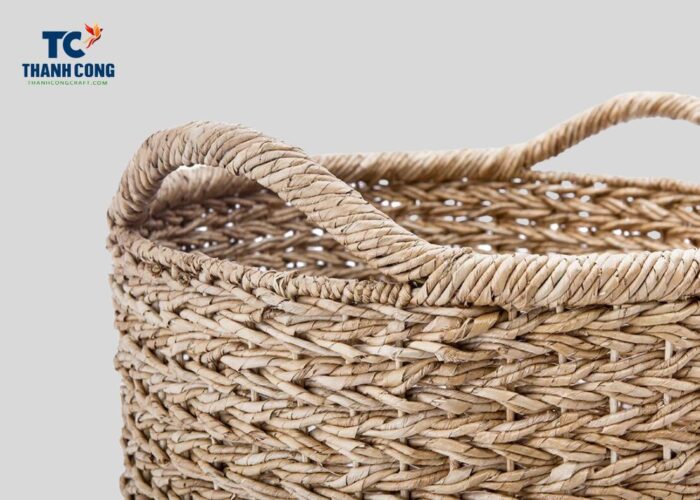
This seagrass weaving style has strong and long-lasting qualities. People use it to make baskets, lamps and carpets. This material is often woven on metal frames. As a result, it can provide reliability when applying objects in space.
Although a metal frame is not required for all twisted seagrass baskets, it will assist maintain the basket’s robustness.
2.2 Split seagrass
Split seagrass is a popular seagrass weaving pattern. It is manufactured from dried seagrass. Because the machine allows for uniformity in the splitting process width, people split into long thin threads by the machine
Seagrass is still a robust substance despite being sliced in half. Seagrass is an extremely durable material. However, without an iron frame, this material will struggle to retain large goods for an extended period of time. Customers must therefore consider the intended use while purchasing.
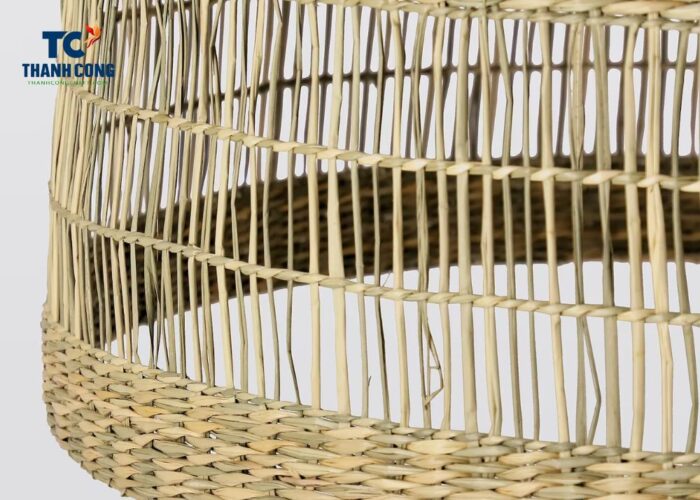
2.3 Braided seagrass
This is also one of the seagrass varieties with a prominent seagrass weaving form. Skilled artisans use it to produce lovely, rustic goods. Braided sedge is made up of numerous strands of seagrass braided together. It resembles twisted seagrass in appearance, but the technique of manufacture is different.
Braided seagrass is knitted in a variety of diameters and braid designs. Of these, three or five braids are the most popular. Because home décor wholesalers frequently create baskets without iron frames, production time for products made with this material is usually short.
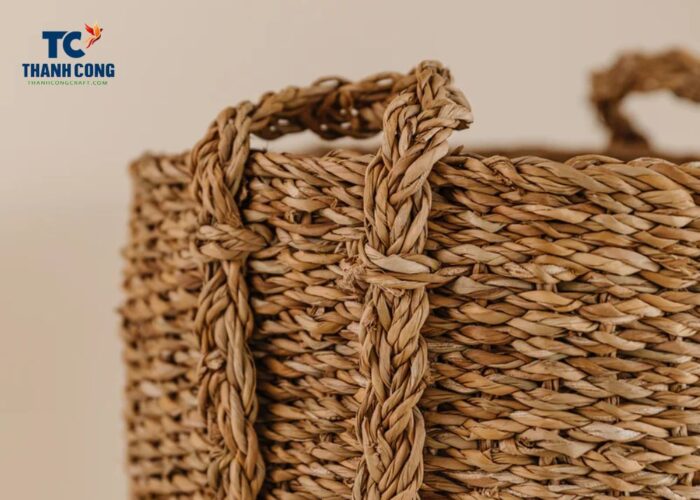
2.4 Pressed seagrass
Seagrass fibers that have been crushed or flattened by machine and then knitted into various products. Despite its lightness and softness, pressed seagrass is quite durability. Products manufactured from pressed seagrass, on the other hand, will not be able to retain heavy objects within if they are not braided with a metal frame.
You can see this type of seagrass weaving on many products such as baskets, planters, bags, packs, shopping bags, etc. One of the most popular items is the sedge belly basket. Pressed seagrass products usually have a natural hue.
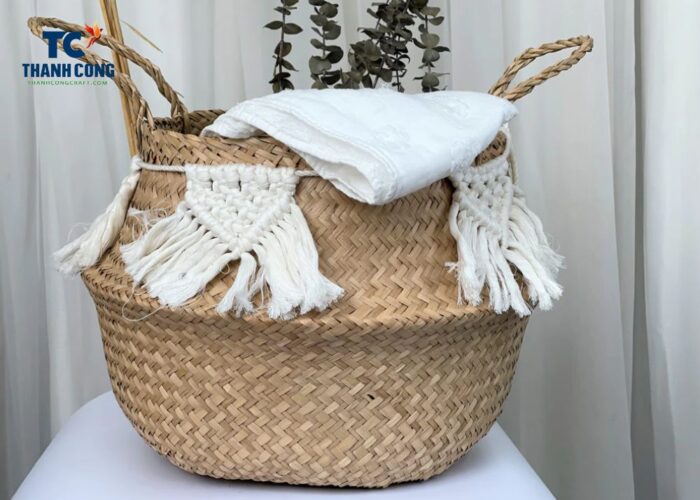
2.5 Coiled seagrass
Coiled seagrass that has been rolled and bundled together. Because it is thick, it was similar in appearance to rattan products. Grass weaving techniques, on the other hand, is frequently braided with plastic string to produce color diversity. Seagrass with plastic string is the collective term for such items. You can also rely on this feature to distinguish if you are unable to touch the merchandise.
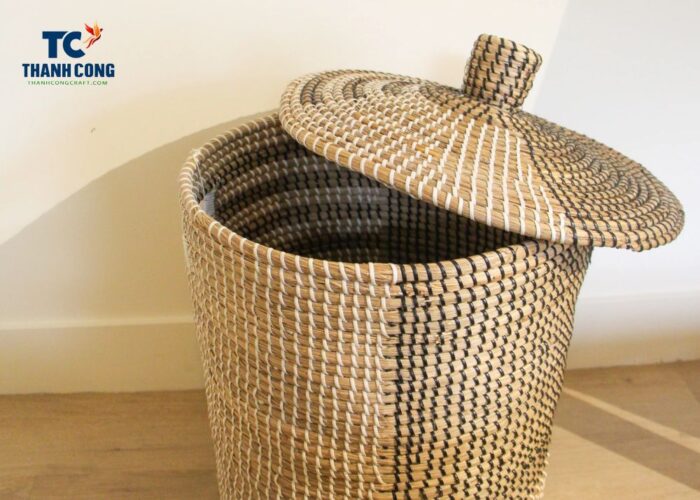
The benefit of coiled seagrass woven yarn is undeniable. It can hold heavy goods for an extended period. As a result, they’re frequently used to build huge storage baskets. It’s also utilized to create one-of-a-kind wall hangings that won’t bend or deform with age.
2.6 Wrapped Seagrass
This seagrass wrapping technique is similar to the twisting or braiding of seagrass. Wrapping sedge, on the other hand, is usually a method of creating a product by wrapping plastic rope around seagrass and then knitting or joining the ropes together neatly into goods.
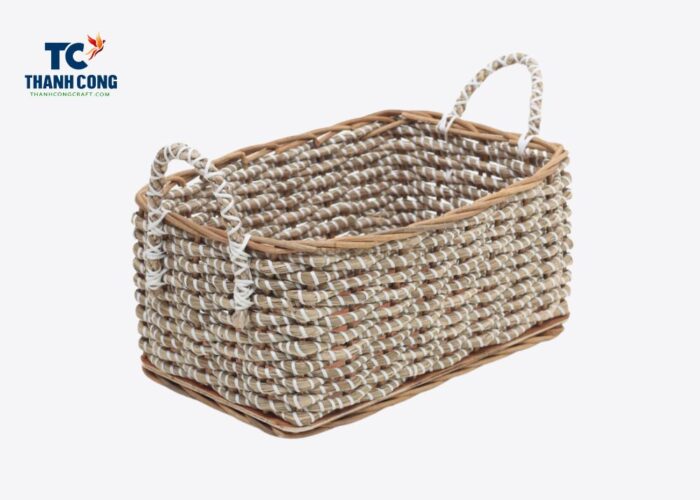
In items with seagrass wrapped, people often use rattan frames to replace metal frames. Wrapped seagrass is similar to rolled seagrass in terms of thickness and durability.
The products manufactured from these two seagrass weaves are frequently fairly costly. Because the material includes both sedge and plastic rope. Because more complicated knitting techniques are required, the product’s worth is likewise higher.
3. Products Made from Seagrass?
3.1 Rope
The product rope made from seagrass is an environmentally friendly type of rope, made from natural material of seagrass. This product has many advantages such as durability, beauty, ease of use and recyclability. It can be used for decoration, packaging, tying goods or making handicrafts.
This product also contributes to protecting the marine environment, reducing plastic pollution and creating income for coastal people.
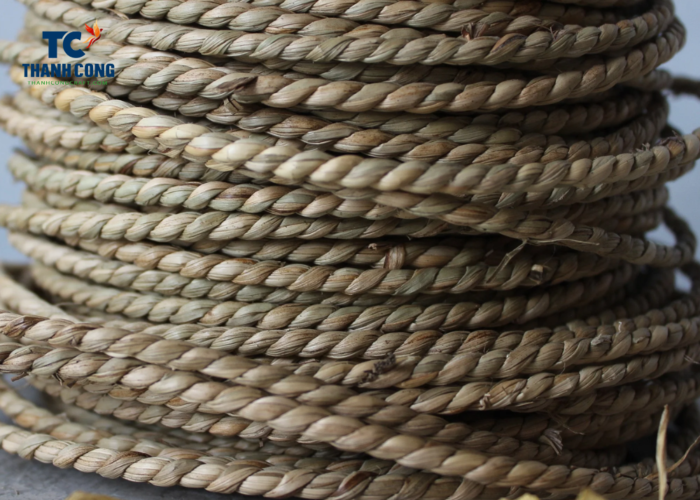
3.2 Seagrass basket
Seagrass basket weaving is a captivating art form that beautifully marries the natural elegance of seagrass fibers with the skillful hands of artisans. The inherent beauty and texture of seagrass contribute to the visual allure of the baskets, creating functional pieces that double as aesthetic accents for any space.
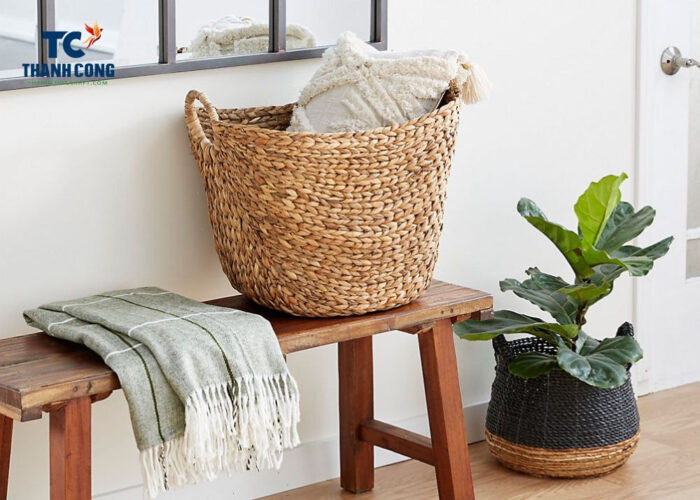
Check out Seagrass weaving instructions for baskets: how to make a seagrass basket
3.3 Woven seagrass chair seat
The woven seagrass chair seat, a harmonious blend of comfort and natural sophistication. Crafted from resilient seagrass fibers, this chair seat not only provides a uniquely textured and inviting sitting experience but also brings a touch of organic elegance to any room. Its neutral tones and durable construction make it a versatile addition to various interior styles, while the sustainable and easy-to-maintain qualities ensure a lasting and eco-friendly seating solution.
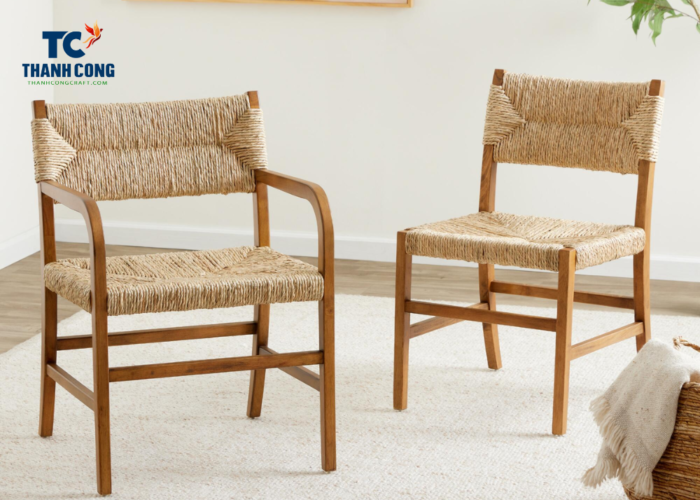
3.4 Seagrass rugs
Seagrass rugs are an essential element in our homes. Besides keeping our feet warm on chilly days, seagrass rugs also serve as decor, enhancing the aesthetics of a room. Since seagrass is a natural material, it doesn’t cause skin irritation and is safe for both the elderly and children.
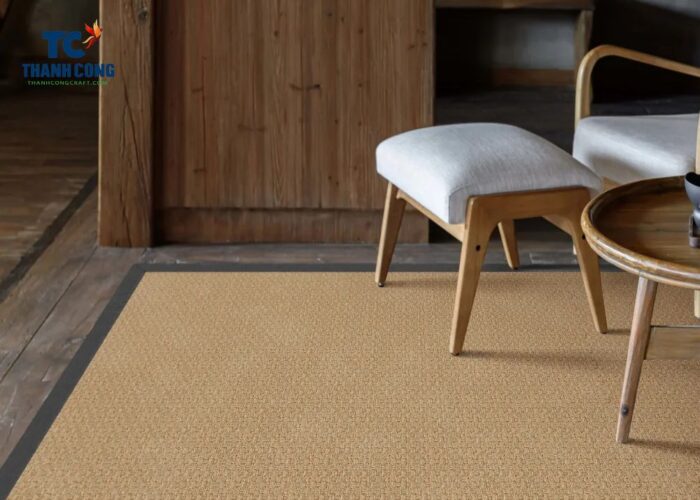
3.5 Seagrass wall hangings
Apart from the conventional rugs used for floor decoration, there is another type of seagrass product used for wall hangings and artistic embellishments: seagrass wall hangings. These unique pieces function as attractive fabric tapestries, adding beauty to the wall space.
4. FAQs
4.1 Where to buy seagrass for weaving?
There are many places to buy seagrass for weaving. You can find seagrass, seagrass weaving supplies at craft stores, online shopping websites or local production facilities. Seagrass is a durable and easy-to-clean material, often used to weave products such as rugs, baskets or cushions.
When buying seagrass, you should choose the type that has the color and size suitable for your project. You should also check the quality of the seagrass, see if it is torn, rotten or damp. In addition, you should compare the prices and shipping costs of different suppliers to save money.
4.2 What are the negatives of seagrass?
The negatives of seagrass include its vulnerability to various threats, such as climate change, urbanization, tourism, and overfishing. These factors can lead to the loss and decline of seagrass, impacting the biodiversity and ecosystem services of coastal areas.
Seagrass is also dependent on sunlight for photosynthesis, limiting its growth to specific depths. Water turbidity caused by pollutants like waste, fertilizers, and sediments can reduce light penetration, affecting the growth and reproduction of seagrass.
Additionally, seagrass can pose challenges for human activities, such as diminishing underwater visibility for recreational purposes, entangling fishing nets, or causing allergies in individuals who come into contact with them. Recognizing these negatives and implementing sustainable practices are crucial for preserving the ecological significance of seagrass ecosystems.
4.3 Why are seagrass baskets so expensive?
Seagrass baskets often carry a higher price due to labor-intensive cultivation and harvesting processes, often undertaken by skilled artisans. The meticulous handcrafting of these baskets, coupled with the unique qualities of seagrass as a natural and sustainable material, contributes to their overall cost.
Additionally, the weaving process, especially for intricate designs, demands a high level of craftsmanship, further adding to the time and effort invested. Despite the higher upfront expense, many consumers value the durability, unique texture, and eco-friendly nature of seagrass baskets, justifying the investment in these handmade and environmentally conscious products.
If you have any further questions about seagrass for weaving, don’t hesitate to send thanhcongcraft an email us at info@thanhcongcraft.com or message us at WhatsApp: +84967485411. Hope to serve you soon! Best regard!


